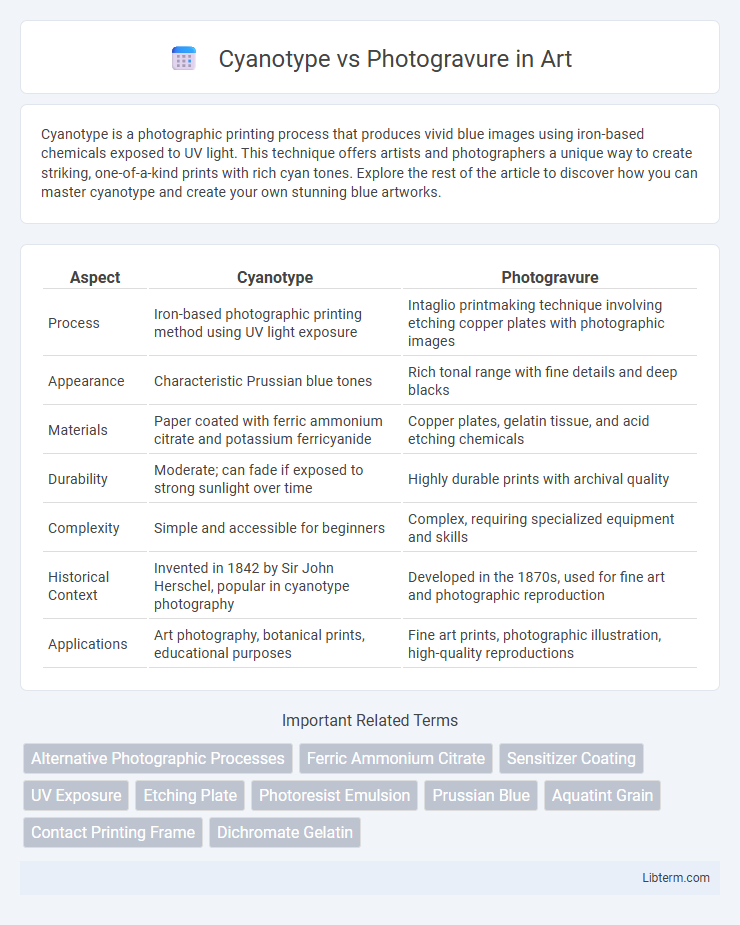Cyanotype is a photographic printing process that produces vivid blue images using iron-based chemicals exposed to UV light. This technique offers artists and photographers a unique way to create striking, one-of-a-kind prints with rich cyan tones. Explore the rest of the article to discover how you can master cyanotype and create your own stunning blue artworks.
Table of Comparison
| Aspect | Cyanotype | Photogravure |
|---|---|---|
| Process | Iron-based photographic printing method using UV light exposure | Intaglio printmaking technique involving etching copper plates with photographic images |
| Appearance | Characteristic Prussian blue tones | Rich tonal range with fine details and deep blacks |
| Materials | Paper coated with ferric ammonium citrate and potassium ferricyanide | Copper plates, gelatin tissue, and acid etching chemicals |
| Durability | Moderate; can fade if exposed to strong sunlight over time | Highly durable prints with archival quality |
| Complexity | Simple and accessible for beginners | Complex, requiring specialized equipment and skills |
| Historical Context | Invented in 1842 by Sir John Herschel, popular in cyanotype photography | Developed in the 1870s, used for fine art and photographic reproduction |
| Applications | Art photography, botanical prints, educational purposes | Fine art prints, photographic illustration, high-quality reproductions |
Introduction to Cyanotype and Photogravure
Cyanotype is a photographic printing process that produces a distinctive blue print using iron salts, primarily ferric ammonium citrate and potassium ferricyanide, exposed to ultraviolet light. Photogravure is an intaglio printmaking technique that transfers photographic images onto copper plates coated with light-sensitive gelatin, allowing for high-resolution prints with rich tonal variations. Both processes highlight unique historical photographic methods but differ significantly in materials, exposure techniques, and visual outcomes.
Historical Background of Both Processes
Cyanotype, developed by Sir John Herschel in 1842, is one of the earliest photographic printing processes, recognized for its distinctive Prussian blue color and simple chemistry using ferric ammonium citrate and potassium ferricyanide. Photogravure, invented by Karel Klic in the 1870s, refined intaglio printing by combining photography and etching techniques to produce high-quality, continuous-tone images on metal plates for printing. Both processes significantly influenced 19th-century image reproduction, with cyanotype favored for its ease and affordability, while photogravure was esteemed for its rich tonal range and archival permanence.
Core Principles and Techniques
Cyanotype relies on a photosensitive solution of ferric ammonium citrate and potassium ferricyanide that reacts to ultraviolet light to produce a cyan-blue print, ideal for simple, high-contrast images. Photogravure involves etching an image onto a copper plate using acid baths after transferring a gelatin film positive, enabling detailed tonal reproductions with rich gradations. While cyanotype emphasizes quick, low-cost contact printing, photogravure demands a complex intaglio process that excels in fine detail and archival quality.
Materials and Equipment Needed
Cyanotype requires basic materials including ferric ammonium citrate, potassium ferricyanide, watercolor paper or fabric, and a UV light source or natural sunlight for exposure. Photogravure involves more complex equipment such as a copper plate, rosin powder, etching tools, an aquatint box, and a printing press for transferring the image. While cyanotype is accessible for beginners with minimal tools, photogravure demands specialized materials and professional-grade equipment, reflecting its intricate printmaking process.
Visual Aesthetics: Comparing Image Outcomes
Cyanotype produces images with distinctive rich blue tones and high contrast, creating a strikingly ethereal, almost painterly quality. Photogravure, in contrast, yields highly detailed, continuous-tone prints with a wide grayscale range, offering fine textural nuances and depth. The blue monochrome of cyanotypes contrasts sharply with the photographic realism and subtle gradations found in photogravure prints.
Process Complexity and Learning Curve
Cyanotype involves a straightforward process using iron-based chemicals and sunlight exposure, making it accessible for beginners with minimal technical skill requirements. Photogravure, by contrast, demands intricate photochemical etching and requires mastery of specialized equipment for transferring images onto metal plates, resulting in a significantly steeper learning curve. The complexity of photogravure limits its accessibility to experienced practitioners, whereas cyanotype offers a simpler, more intuitive entry point into alternative photographic printing techniques.
Durability and Longevity of Prints
Cyanotype prints exhibit excellent longevity due to their iron-based chemical composition, resisting fading under light exposure for decades when properly preserved. Photogravure prints, created through intaglio printing on high-quality paper, demonstrate superior durability thanks to their deep ink deposition and archival materials. Both processes ensure long-lasting artwork, but photogravure generally offers enhanced resistance to physical wear and environmental factors.
Artistic Applications and Modern Usage
Cyanotype and photogravure are distinctive printmaking techniques favored for their unique artistic qualities and modern applications. Cyanotype, known for its striking blue tones and ease of use, is popular among contemporary artists for creating textured, ethereal images on textiles and paper, often integrated into mixed media projects. Photogravure offers high-resolution, continuous-tone prints with rich detail and tonal depth, making it a preferred choice for fine art editions and photographic reproductions in galleries and museums.
Environmental Impact of Each Process
Cyanotype printing uses iron salts and requires no toxic chemicals, making it an eco-friendlier option with low environmental impact. Photogravure involves etching copper plates with acids and solvents, generating hazardous wastewater and metal waste that require careful disposal to prevent pollution. Comparing both, cyanotype presents a significantly greener alternative due to its minimal chemical use and simpler waste management.
Choosing the Right Process for Your Art
Cyanotype offers a cost-effective, straightforward process producing vibrant blue prints with distinct texture, ideal for artists seeking a vintage aesthetic and quick results. Photogravure, a more complex intaglio printmaking technique, provides exceptional detail and tonal range suitable for fine art photography and high-quality reproductions requiring archival longevity. Selecting between cyanotype and photogravure depends on your desired visual effects, budget constraints, and whether you prioritize speed or intricate detail in your artistic expression.
Cyanotype Infographic

 libterm.com
libterm.com